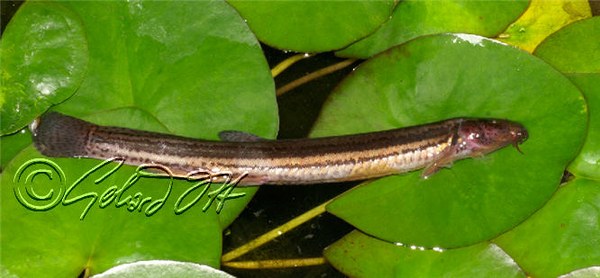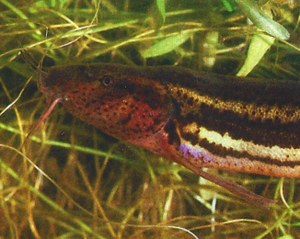Misgurnus fossilis
Summary
Scientific name: Misgurnus fossilis (Linnaeus, 1758)
Common name: Eurasian Weather Loach, Weatherfish
Synonyms: Cobitis fossilis

Distribution: Europe - north of the Alps, from River Meuse to the east to the River Neva-drainages. Northern Black Sea basin from River Danube to the east to Kuban. Caspian basin in River Volga and River Ural drainages. Introduced to other areas.
Sexual Dimorphism: Males have longer pectoral fins, more noticeable from above.

Maximum size: normally up to 27cm (10.6"), however, some fishermen have said that they caught specimens measuring up to 45cm (17.7") in the past.
Similar to: Misgurnus anguillicaudatus, Misgurnus mizolepis.
Care: Misgurnus fossilis require a spacious aquarium with as large a footprint as possible. Adults are powerful fish and are very active at night - do ensure the tank has tight fitting coverslides. This is a sociable species which is best kept in groups of 5 or more. Appreciates shady cover including caves, robust planting and large bogwood pieces that stretch from the bottom of the aquarium right up to the surface. M. fossilis does like to dig, so be sure to provide them with a smooth substrate in order to protect the delicate sensory barbels. Do not be surprised if they rearrange the decor!

Above: Natural habitat of M. fossilis in Aukrug in Schleswig-Holstein, Germany - courtesy of Gerhard Ott.
Feeding: Easy to feed - accepts flakes/crisps, sinking pellets/granules, frozen foods such as mosquito larvae & shrimp, also earthworms from a clean source.
Water parameters: pH: 7.0-8.0. Hardness: medium-hard. Max dh: 25
Temperature: 50ºF to 72ºF (10-22°C)
Breeding: some fishermen breed M. fossilis for purposes of species protection; very rarely is this for the ornamental fish trade. In nature, the fish spawn during the Spring. The male wraps himself around the female and eggs and sperm are released. The eggs settle in the substrate. For successful breeding in the aquarium, overwintering (a prolonged cold period) is necessary, with temperatures allowed to drop as low as 39°F (4°C). At this time, the loaches will be completely inactive and do not eat.

Notes
Misgurnus fossilis is a cold-water fish. It can be kept in garden ponds (but the pondkeeper will see it very rarely). In England, a permit is required to sell or keep M. fossilis. This is to help prevent accidental release into native waters where it is thought this species could survive, even during the cold winters.

Above: catching M. fossilis from a pond, courtesy of Gerhard Ott.
Like its congeners, M. fossilis has the ability to survive poor conditions by swallowing atmospheric air and passing it through the gut, extracting oxygen internally. Excess air is expelled via the anus. This ability has led to fish being found alive encased in mud, with no actual water present during prolonged or sudden dry periods.
In the 19th century this species was a food fish and this is the reason it was introduced to other areas.
Photo Gallery
Click to view all images of this species! |
Document Actions


